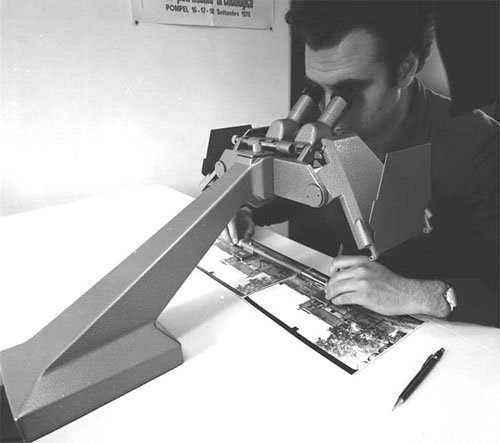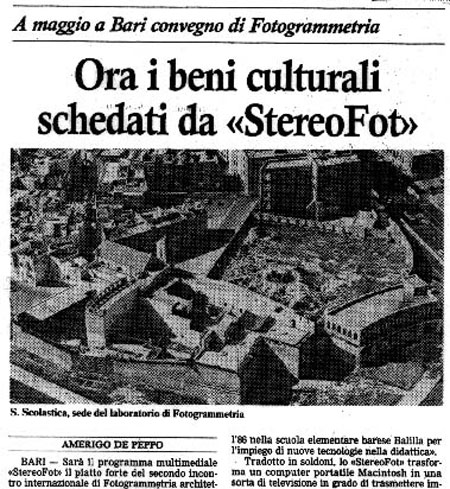The StereoFot program
Considering that the only photogrammetric (optical-mechanical) restitutor of the laboratory could not be used by all the students of the course, the exercises on the restitution were carried out with a programmable calculator, exploiting the bi-univocal correspondence between the coordinates-plate (detected directly from the prints of the photogramm) and the ground coordinates.
With the arrival of the calculator, the StereoFot program (short for stereophotogrammetry) was born, with the initial name of Pluto and written in the HyperCard language.
The aim of the software was to return the frames obtained with the Wild C120 stereometric chamber, supplied to the laboratory and, to accommodate gray-level images, it was rewritten in the SuperCard language (Stereofot 1.0) using the formulas of the normal case.
Thanks to the interest aroused, it was presented at the XIV International Symposium of the C.I.P.A. (Comité International de Photogrammétrie Architecturale) held in Delphi (Greece) in October 1991.
In 1992, in order to remove it from economic interests and guarantee its free use, it was registered with the Bari Chamber of Commerce and was presented (on an Apple Macintosh LC computer, equipped with a viewer and transformed into a digital restitutor) to the XVII ISPRS (International Society for Photogrammetry and Remote Sensing) Congress, held in Washington DC from 6 to 14 August.
In 1993, on the occasion of the 2nd International Conference of Architectural Photogrammetry [5], held in Bari on 26 - 27 - 28 May, the StereoFot program was presented as software used for the first operational example of the International Center for Digital Photogrammetric Documentation of Sacred Architecture.
Return with the use of the stereomicrometer

The Apple Macintosh LC computer, equipped with a display, presented in Washington 
from "LA GAZZETTA DEL MEZZOGIORNO" of Monday 12 April 1993

Three days of work, during which the didactic activity, also carried out in elementary schools, the relevant experience and documentation carried out in Romania on behalf of the local railways and the formation of the photogrammeter within the European Community will be transferred to "x-rays". > Big names of the sector at European level will participate in the conference: among them, Professor Armin Grun, of the Polytechnic of Zurich, Professor John Badekas, of the Polytechnic of Athens, Ross W. Dallas, of the University of York Maurice Carbonell of the IGN of Paris and Professor Mario Fondelli of the University of Florence.
But what is the "StereoFot" program? "It is a system - explains Pietro Grimaldi, president of the Italian architectural photogrammetry foundation, which organizes the congress in collaboration with the chair of architectural photogrammetry of the Bari Polytechnic - which allows the creation of an open multimedia card for the documentation of cultural heritage, aimed at involving university and middle school students in this project. This is the continuation of the experimentation carried out from 85 to 86 in the Balilla elementary school in Bari for the use of new technologies in teaching ".
Translated in a nutshell, the "StereoFot" transforms a Macintosh laptop into a sort of television capable of transmitting digital images relating to the findings made. The result is an easily accessible and certainly more suggestive database of "cold" records, not to mention the old records on which the goods in question are still used to catalog.
"With photogrammetry - explains Professor Antonio Daddabbo of the Polytechnic of Bari - we can simulate the visual system of a giant, capable of taking a skyscraper between his fingers, when we want to observe a city, or that of an insect, when the The object of our attention is a model. The conference in May is linked to the experience of that of '91, in the sense that it constitutes a verification of the theories presented by the chair and the Foundation there, theses that have had a significant confirmation at an international conference in Washington. What I would like to reiterate once again is that the increasingly massive contribution of technologies must in any case be aimed at recovering that concept of school shop that places human ingenuity at the center of every research. In practice, it is necessary to recover the teaching activity of the craftsman, who taught the trade to his workers, who thus became non-passive subjects but they themselves builders of their own learning. ";